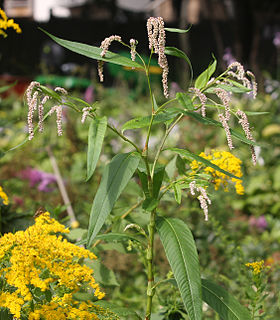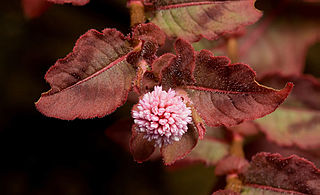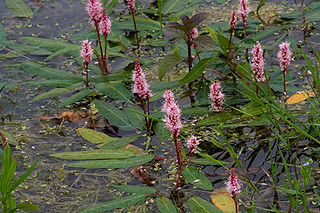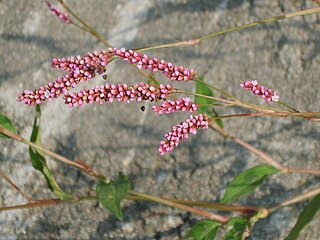
Bistorta officinalis, known as bistort, common bistort, European bistort or meadow bistort, is a species of flowering plant in the dock family Polygonaceae native to Europe and north and west Asia. The generic placement of this species is in flux. While treated here in Bistorta, it has also been placed in Polygonum or Persicaria. Other common names include snakeroot, snake-root, snakeweed and Easter-ledges.

Polygonum is a genus of about 130 species of flowering plant in the buckwheat and knotweed family Polygonaceae. Common names include knotweed and knotgrass. In the Middle English glossary of herbs Alphita, it was known as ars-smerte. There have been various opinions about how broadly the genus should be defined. For example, buckwheat has sometimes been included in the genus as Polygonum fagopyrum. Former genera such as Polygonella have been subsumed into Polygonum; other genera have been split off.

Persicaria maculosa is an annual plant in the buckwheat family, Polygonaceae. Common names include lady's thumb, spotted lady's thumb, Jesusplant, and redshank. It is widespread across Eurasia from Iceland south to Portugal and east to Japan. It is also present as an introduced and invasive species in North America, where it was first noted in the Great Lakes region in 1843 and has now spread through most of the continent.

Persicaria pensylvanica is a species of flowering plant in the buckwheat family, Polygonaceae. It is native to parts of North America, where it is widespread in Canada and the United States. It has also been noted as an introduced species in parts of Europe and South America. Common names include Pennsylvania smartweed and pinkweed.

Persicaria lapathifolia, known as pale persicaria, is a plant of the family Polygonaceae. It is closely related to Persicaria maculosa and as such is considered a weed in Britain and Europe. Other common names for the plant include pale smartweed, curlytop knotweed, and willow weed. It is a species complex made up of a great many varying forms, sometimes considered varieties. The environment also has a strong influence on the morphology of an individual plant.

Persicaria tinctoria is a species of flowering plant in the buckwheat family. Common names include Chinese indigo and "Japanese indigo." It is native to Eastern Europe and Asia.

Persicaria virginiana, also called jumpseed, Virginia knotweed or woodland knotweed is a North American species of smartweed within the buckwheat family. It is unusual as a shade-tolerant member of a mostly sun-loving genus. Jumpseed is a perennial, named for its seeds which can "jump" several feet when a ripe seedpod is disturbed.
Pink knotweed is a common name for several plants in the knotweed family (Polygonaceae) and may refer to:

Persicaria bicornis is a North American species of flowering plants in the buckwheat family common name, pink smartweed. It is native to the central and southwestern United States from northern Texas west to Arizona, east to Louisiana and north as far as eastern Wyoming, South Dakota, Iowa, and Illinois.

Persicaria capitata, the pink-headed persicaria, pinkhead smartweed, pink knotweed, Japanese knotweed, or pink bubble persicaria, is an Asian species of plants in the genus Persicaria within the buckwheat family. It is native to Asia and grown as an ornamental in other countries. It has become naturalized in Australia, South Africa and a few scattered locations in the United States.
Persicaria cespitosa, known as tufted knotweed, is a summer annual weedy plant of the family Polygonaceae, native to eastern Asia, from China to Japan and Southeast Asia, and introduced into North America. The plant grows to 3.5 feet (105 cm) in height with elliptic to lanceolate leaves, usually 20–75 mm long. It has small pink or red flowers arranged in tight terminal spikes.

Persicaria amphibia is a species of flowering plant in the knotweed family known by several common names, including longroot smartweed, water knotweed, water smartweed, and amphibious bistort. It is native to much of North America, Asia, Europe, and parts of Africa, and it is known elsewhere as an introduced species and sometimes a noxious weed.

Persicaria punctata is a species of flowering plant in the knotweed family known by the common names dotted smartweed and dotted knotweed.
Kudzu of the North may refer to:
Mile-a-minute may refer to:

Persicaria longiseta is a species of flowering plant in the knotweed family known by the common names Oriental lady's thumb, bristly lady's thumb, Asiatic smartweed, long-bristled smartweed, Asiatic waterpepper, bristled knotweed, bunchy knotweed, and tufted knotweed. It is native to Asia, and it is present in North America and Europe as an introduced species and often a weed.

Persicaria hydropiperoides is a New World species of flowering plant in the buckwheat family known by the common names swamp smartweed and false waterpepper. It is widespread across much of North America and South America. It grows in moist and wet habitats, and is sometimes semi-aquatic.














